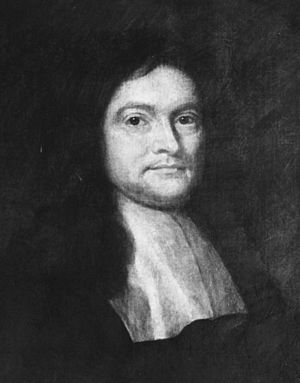Daniel Whistler facts for kids
Daniel Whistler (born 1619, died 1684) was an important English doctor. He was known for his medical studies and for being a leader at the Royal College of Physicians. He also wrote the first printed book about a disease called rickets.
Contents
The Life of Daniel Whistler
Daniel Whistler was born in 1619 in Walthamstow, a town in Essex, England. His father was William Whistler from Elvington, Oxfordshire. Daniel went to school in Thame, Oxfordshire, and then studied at Merton College, Oxford, starting in 1639. He earned his first degree, a Bachelor of Arts (B.A.), in 1642.
After that, Daniel decided to study medicine. He went to Leiden University in the Netherlands in August 1642. While he was there, he also returned to Oxford to get his Master of Arts (M.A.) degree in 1644. He finished his medical studies and became a Doctor of Medicine (M.D.) in October 1645. Later, in 1647, he was officially recognized as an M.D. at Oxford. In 1649, he was chosen to be a fellow of the important Royal College of Physicians.
Whistler's Work and Travels
In 1648, Daniel Whistler became a professor of geometry at Gresham College in London. He also held a special teaching position at Oxford.
During a war between England and the Netherlands (the First Anglo-Dutch War), Whistler helped set up places to treat injured soldiers. These stations were in areas like Portsmouth and East Anglia. He worked with a woman named Elizabeth Alkin to make sure both English and Dutch soldiers received care.
In 1653, he was asked to travel to Sweden with a diplomat named Bulstrode Whitelocke. While in Sweden, Whistler treated people with injuries, like a broken arm and a broken leg. He was good at setting bones himself! He could speak both Latin and French, which was very helpful for his travels. He even wrote Latin poems about Queen Christina of Sweden when she gave up her throne. He returned to London in 1654.
Leadership at the College of Physicians
Daniel Whistler was very active at the Royal College of Physicians. In 1659, he gave the Harveian oration, which is a special speech given each year. He served many times as a "censor," which meant he helped make sure doctors followed the rules. He was also the registrar (who kept records) from 1674 to 1682, and the treasurer (who managed money) in 1682. Finally, in 1683, he became the president of the College of Physicians, which was a very important role.
Whistler was known to be a friendly person. He often spent time with famous people like Samuel Pepys, who wrote a famous diary. Pepys mentioned dining and talking with Whistler. They even walked together to see the damage after the Great Fire of London in 1666. Another famous diarist, John Evelyn, also enjoyed talking with him.
Daniel Whistler got married in 1657. He passed away on May 11, 1684, from pneumonia, while he was still president of the College of Physicians. He was buried at Christ Church, Newgate Street in London.
Whistler's Medical Writings
Daniel Whistler's most famous work is his medical paper from 1645, called De Morbo puerili Anglorum, quern patrio idiomate indigense vocant "The Rickets." This long Latin title means "On the childhood disease of the English, which in their native language they call 'The Rickets.'" This paper was the first printed book ever written about rickets. He reprinted it again in 1684.
At that time, many doctors were studying rickets. A group of seven doctors from the College of Physicians, including Francis Glisson, were working on it. Glisson later published a much more detailed book about rickets in 1650. Whistler's paper didn't have new discoveries, but it shared many ideas and thoughts from other doctors. It showed that he was part of the important discussions happening about the disease. He even suggested a very long new name for the disease, 'Paedossplanchnosteocaces,' but no one else ever used it!


